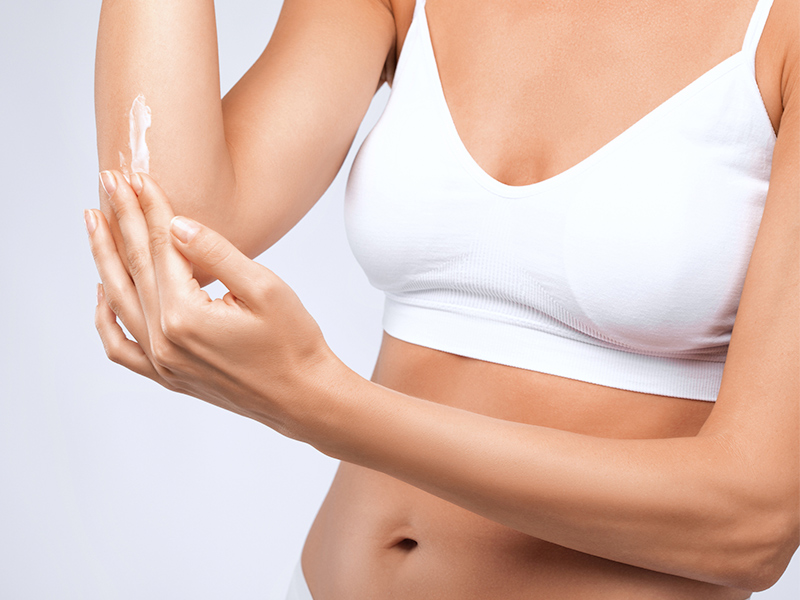The rare, but painful skin condition caused by a common treatment
Topical steroid withdrawal, which can cause burning, weeping, stinging skin, has been gaining plenty of attention on social media lately. Here’s what you need to know.
Topical steroid creams are a commonly prescribed treatment for eczema, but in rare cases, discontinuing use can have very painful consequences.
Logan Shine, the pregnant fiancée of Western Bulldogs star Jason Johannisen, recently revealed on Instagram she is suffering from the debilitating skin condition known as topical steroid withdrawal.
Logan said she was speaking out in the hope of warning others about TWS, saying “my body is in pain every day”.
“My skin makes it hard to sleep at night, go out anywhere, or just look in the mirror,” Logan wrote.
She’s not alone in sharing her TWS experience on social media.
As of mid-August videos with the hashtag #topicalsteroidwithdrawal showing dramatic pictures of sufferers with red, cracked and scaling skin on their faces, torso and feet had garnered more than 367.4 million views on TikTok.
View this post on Instagram
- Skin condition: More than a million Aussies have eczema. Here’s how to treat it
What is topical steroid withdrawal?
Chair of Royal Australian College of General Practitioners Specific Interests Dermatology, Dr Jeremy Hudson explains topical steroid creams are used as a first line management of patients with eczema and are applied to the affected area to reduce inflammation and allow healing.
“Withdrawal is a rare complication of this treatment and is more likely to occur with strong steroids being used frequently or over a long time, particularly on the face and genital regions,” Dr Hudson says.
Sydney dermatologist Dr Li-Chuen Wong says topical steroid withdrawal may occur when someone is doing well and wants to stop treating their rash.
“Once they withdraw the steroid medication, the area they were treating previously can, in rare occasions, become inflamed with a reaction that doesn’t present as their usual eczema,” Dr Wong says.
- Urge to scratch: Itchy skin driving you nuts? You may have one of these conditions
What does topical steroid withdrawal look like?
Symptoms of TSW include red skin that burns, stings, cracks, peels, itches and flakes.
It may also present as small pus-filled bumps around the nose, eyes and mouth.
These generally begin to appear in the days or weeks after steroid treatment is stopped.
“The severity and pattern of withdrawal symptoms can vary significantly but will most commonly present after stopping a steroid as ‘burning red skin’ or a rash with pustules,” Dr Hudson says.
“Symptoms may either be prolonged or cycle through periods of abnormal and then relatively normal skin.”
A 2015 study found most reported cases were among women.
How is topical steroid withdrawal treated?
As TSW is rare and researchers don’t yet know why some people develop the debilitating condition, the RACGP says avoiding the prolonged use of moderate-to-potent topical steroids on the face could be prudent.
“The experience can be particularly stressful for patients, and I’d strongly advise anyone who may be anxious, depressed or have difficulty sleeping due to symptoms see their GP,” Dr Hudson says.
“Like any medication, it’s important for patients to have an informed discussion about the relative risks of topical steroid addiction and withdrawal, so they can make an educated decision and be on the lookout for any potential side effects.
“Some patients may want to cease topical steroids due to concerns about using it regularly, and this needs to be balanced against the relatively low risk, and the benefits, of the treatment.”
Seek medical guidance for your eczema treatment
Dr Wong warns patients against developing “steroid phobia” because of the social media storm.
“Topical steroids are inexpensive and effective and it’s hugely important that people keep treating their eczema, which affects about 20 per cent of the Australian population,” Dr Wong says.
“There are different treatment options available including nonsteroidal topical alternatives, antihistamines and moisturisers that can be used to heal the skin and minimise flare-ups.
“Don’t give up – speak to your dermatologist or your doctor, it may be that there are underlying issues that need to be resolved. Help really is available.”
- Perfect complexion: Is our quest for smooth, flawless skin in vain?
Written by Liz McGrath.





